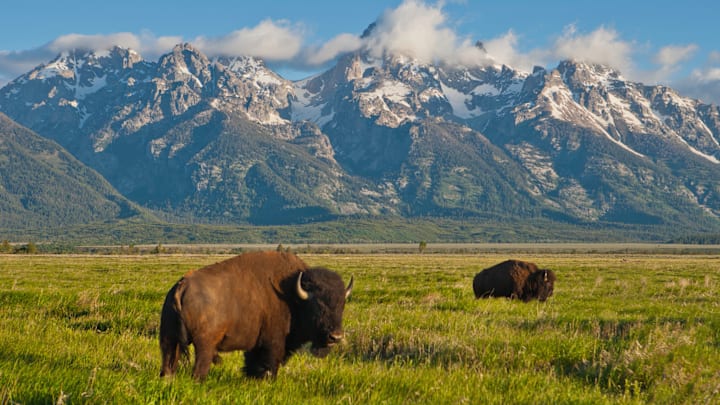Chances are, anyone taking a trip out west to a national park like Grand Teton or Yellowstone will see plenty of bison dotting the plains. Or are they buffalo? Is there a difference between the two?
“In North America, the names are used interchangeably for the species Bison bison,” Ross MacPhee, Curator Emeritus in Department of Mammalogy at the American Museum of Natural History, told Mental Floss in 2014.
But though both bison and buffalo are bovids, or members of the cattle family, there are some definite differences between them. “Elsewhere—in non-English-speaking Europe, for example—a bison is the European Bison, Bison bonasus, a species very closely related to B. bison,” MacPhee said. “A buffalo is either a Cape Buffalo Syncerus (Africa), or Water Buffalo Bubalus (South Asia), neither of which are closely related to either kind of bison.”
So if you’re yearning for a home where the buffalo roam, you’d better move to another continent.
How to Tell the Difference Between Bison and Buffalo

To tell the difference between a buffalo and a bison, “just look at the horns,” MacPhee said. “[Bison’s] are like typical cow horns; in buffalo, they are relatively huge, sweeping arcs.” Bison also have a large shoulder hump.

Telling the difference between the two species of bison is slightly tougher. “An average male European bison has less hair, especially in the cape, or mane,” MacPhee explained. ”Allegedly there is a difference in the angulation of the horns, but I don’t see it, or it’s too variable to be useful.”
Why We Call Bison “Buffalo”
No buffalo have ever lived in North America, according to MacPhee, so how come we call bison by that name? According to the National Park Service, when early explorers came to North America—at which point there may have been as many as 60 million bison on the continent—they thought the animals resembled old world buffalo, and so they called them that. According to the Online Etymology Dictionary, the word comes from the Portuguese bufalo, or “water buffalo,” from the Latin word bufalus, a variant of bubalus, which meant ”wild ox.” (Though some apparently believe that the buffalo came into English from the French word for “beef,” boeuf.) The Lakota word for bison is tatanka.
Bison came very close to extinction. In 1883, there were approximately 40 million of the animals in North America; by the 1900s, hunting had reduced the population to under 1000 animals. The bison you see in the National Parks today were bred from just a few individuals from the Bronx Zoo and Yellowstone. As of 2022, according to the U.S. Fish and Wildlife Service, “there are approximately 20,500 Plains bison in conservation herds and an additional 420,000 in commercial herds. While bison are no longer threatened with extinction, the species faces other challenges. The loss of genetic diversity, combined with the loss of natural selection forces, threatens the ecological restoration of bison as wildlife. A low level of cattle gene introgression is prevalent in most, if not all, bison herds.”
A version of this story ran in 2014; it has been updated for 2023.
